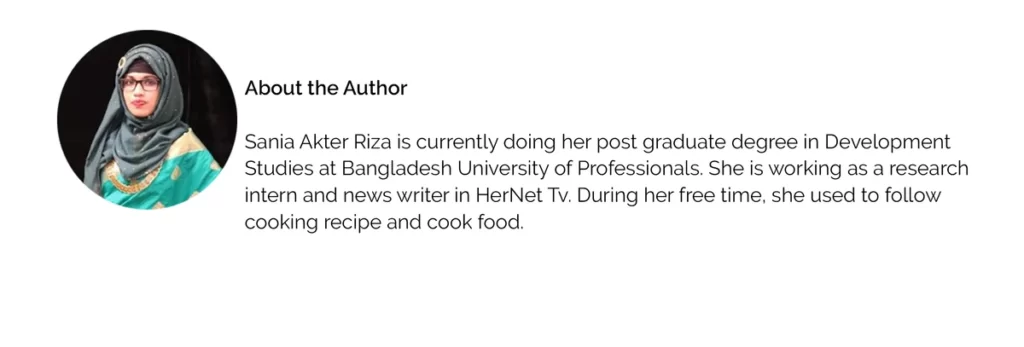By: Sania Akter Riza
The lockdown decision in Bangladesh means that 42 million students, including those already out-of-school, are no longer able to attend school and could be prohibited from doing so until September. Some of those are now studying online for the first time.
Unlike in many developed countries, most children in Bangladesh do not have access to the Internet. This is why the initial education response focused on delivering classes on TV, as television sets are more widely available in households.
UNICEF is working with the Government of Bangladesh to offer effective remote learning programs using TV, radio, mobile phone and Internet platforms to reach the maximum number of students. UNICEF has also helped produce guides to assist teachers that are giving remote classes.
de
Nor Shirin Md. Mokhtar, Chief of Education, UNICEF Bangladesh said “We want to ensure that remote learning is an option for as many children as possible during the COVID-19 crisis.”

With this call to action, to help create more spaces for learning, a web platform was developed by a2i to allow and encourage school-going children and adolescents to collaborate, share knowledge and learn.
Through this platform, students are learning and exploring the website, viewing educational content, and collaborating with their friends to finish their homework. Overall, the students are grateful that online classes have been introduced to help them keep up with their studies.
While this development has been exciting for the many, it is true that online learning has some constraints but the government of Bangladesh has made the path easier during this time with the set up ‘Amar Ghore Amar School’ live classes on Sangsad TV.
Asim Sen, an assistant teacher of a local primary school in Katiadi upazila of Kishoreganj district was worried that the lockdown would hamper the progress of his students. “Away from school and separated from friends, the children have had to sit idle at home with very little social interaction, which is necessary for mental growth. I was worried this situation would not only hinder academic progress, but also take a toll on their mental health,” said Asim Sen.
Then, he found out that the Directorate of Primary Education (DPE), with support from a2i programme began broadcasting digital content for primary level students on Sangsad TV as well as different social media platforms. Asim Sen readily became part of the initiative. He has taken 3 classes so far in the ‘Ghore Boshe Shikhi’ education programme on Sangsad TV and its Facebook page.

Before these initiatives sprung, many Bangladeshi people have a few misconceptions towards online learning, including: online learning is less rigorous; online promotes “cheating” and can’t be efficiently monitored; online learning is fragmented and segregated; and the teachers are inferior. But the introduction to a new ways has been surprisingly embraced by communities across the country. It didn’t happen overnight. The transition could also be credited to the evolution of technology in Bangladesh in recent times.
On the other hand, many parents were worried about the progress in Islamic education as madrasah education is very hard to teach in the absence of an educated scholar. The programme “Amar Ghore Amar Madrasah” was the answer to parents’ worries.
This programme is part of an initiative jointly implemented by the Department of Madrasah Education (DME) and a2i. The students have been following the live classes. Students have found the classes interesting, and they’re glad that they can finish the syllabus through these process.
On Sangsad TV, “Ghore Boshe Karigori Shikkha”, another programme being broadcasting for the technical and vocationl students.
Overall, in collaboration with the Directorate of Primary Education (DPE), the Directorate of Secondary & Higher Education (DHSE), the Department of Madrasah Education (DME) and Directorate of Technical Education (DTE), and with financial support from UNICEF, a2i has been broadcasting over 100 digital content for primary school students (grades 1-5) through Ghore Boshe Ghore Shikhi, a total of 640 content for secondary level students (grades 6-10) through Amar Ghore Amar School, 60 digital content for Higher Secondary Certificate (HSC) students, 190 digital content for madrasah students through ‘Amar Ghore Amar Madrasah’ and a total of 151 content for technical education students through ‘Ghore Boshe Karigori Shikkha’. They are broadcasted on Sangsad TV, and uploaded on various social media platforms such as the Facebook pages of a2i, ICT Division, Ghore Boshe Ghore Shikhi, Amar Ghore Amar School, as well as the YouTube channels of Ghore Boshe Shikhi, Konnect, Konnect Portal and Skills Portal.
Online classes may become a regular thing given how the situation unfolded. It is important to get it right, and make sure that there is no group of students left behind in the process.

